|
This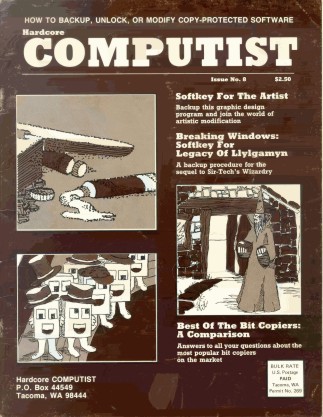 magazine began originally back in 1981 with the name HardCore Computing. A flier mailed out during 1982 gave this description of the magazine: "HARDCORE COMPUTING, a small magazine in Tacoma, Washington, warns pirates about the latest technology that companies are using against them. HARDCORE is a magazine dedicated to the Apple-user. There are a lot of computer magazines, but HARDCORE prints the information that other magazines refuse to print, information vital to you as a computer user."[1] By 1983 it was split into two separate publications: HARDCORE Computist (devoted to "kracking"; see below), and CORE (devoted to general Apple II topics). CORE was to have been published four times a year, but was dropped after only a few issues. The first issues of CORE, during 1983, covered graphics, utilities, and games. The third quarterly issue was to have been about databases, but the games topic was substituted and the database topic never appeared in print.[1],[2],[3] magazine began originally back in 1981 with the name HardCore Computing. A flier mailed out during 1982 gave this description of the magazine: "HARDCORE COMPUTING, a small magazine in Tacoma, Washington, warns pirates about the latest technology that companies are using against them. HARDCORE is a magazine dedicated to the Apple-user. There are a lot of computer magazines, but HARDCORE prints the information that other magazines refuse to print, information vital to you as a computer user."[1] By 1983 it was split into two separate publications: HARDCORE Computist (devoted to "kracking"; see below), and CORE (devoted to general Apple II topics). CORE was to have been published four times a year, but was dropped after only a few issues. The first issues of CORE, during 1983, covered graphics, utilities, and games. The third quarterly issue was to have been about databases, but the games topic was substituted and the database topic never appeared in print.[1],[2],[3]
For the first four issues, the name "HARDCORE" dominated the title page. Beginning with issue #5, "Hardcore" appeared in smaller type, with "COMPUTIST" taking over a dominating position on the cover. By issue #27, the name "Hardcore" was dropped completely from the cover. Although it began as a glossy format magazine, this was discontinued with issue #45 in 1987, and with issue #66 in 1989 they changed to a tabloid format. The publishers claim that one reason for the name change to simply Computist stemmed from a complaint sent in by a young subscriber whose mother was throwing out the magazine before he got it, because she thought it contained pornographic materials![1]
Computist was, admittedly, in the business of teaching users how to "strip". But this did not refer to X-rated topics, but the ability to strip the copy-protection from commercial software. This technique, known as "kracking." was a popular pastime for some software hackers of the day. Using powerful programs such as Locksmith and Copy II Plus, Computist gave specifics on how to make a disk work as easily as a standard Apple DOS disk.[3] The combination of ProDOS and un-protected commercial programs took much of the wind out of Computist's sails, since the special help needed to copy disks was no longer necessary. There were, of course, those who used the techniques printed in Computist to "pirate" programs (duplicate and distribute protected software), but many used it to standardize the modified DOS so that the programs could be used with RAM disks, large floppies, and hard disks.[1]
Though it is still being printed, Computist is much different than it was in its early days. It is no longer Apple II-specific, and has expanded to also cover the Macintosh and IBM. Its publishing schedule has also become rather irregular. Each new subscription still comes with a tutorial by Wes Felty on disk de-protection and the use of a program called "Super IOB".[4]
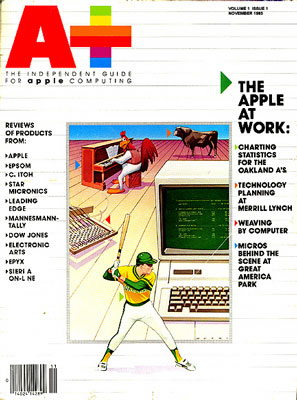
Ziff-Davis, who published other computer magazines such as Creative Computing, began publishing A+ Magazine in November 1983. This new Apple II magazine carried primarily hardware and software reviews and consumer-oriented articles. It was somewhat similar to the later merged magazine, inCider/A+, in terms of being a general interest Apple II magazine as opposed to the programming slant of Nibble (A+ Magazine had virtually no type-in programs).[5] During the time that both A+ Magazine and inCider were being published there continued a friendly rivalry between the two.
One of the features unique to A+ Magazine was a column called "Product All-Stars." a classified-style listing of the current popular software and hardware similar to the old "Fastalk" column in Softalk magazine.
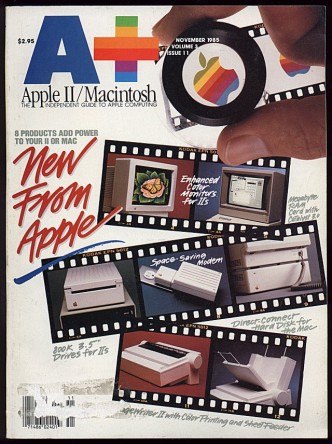
During the latter part of A+ Magazine's publishing run, Gary Little became its editor. He had previously written books about the Apple IIe, IIc, IIGS, and their disk operating systems, and so was very qualified to know the computer and its uses. He replaced Lisa Raleigh, who left to take a job with Apple Computer. Not long after, and just prior to the magazine's merger with inCider, Gary Little also was hired away by Apple. It was felt by some subscribers that Little's short stint with A+ Magazine significantly improved the magazine, and they were saddened to see him go.
When Creative Computing had ceased publication in 1985, subscribers found their remaining issues were switched over to A+ Magazine by Ziff-Davis. In 1989, the publisher chose to discontinue A+ Magazine, and allowed it to merge with inCider magazine.
This magazine was originally begun by Wayne Green, who had been involved in technical magazines for many years. As mentioned above, it was not a programming magazine, though it carried columns that answered reader's questions about programming as well as other Apple II questions. The main direction that it has seemed to take over the years was in helping advertise available software and hardware, and carry articles that helped Apple II users learn to use the software they owned. These columns included "AppleWorks In Action" by Ruth Witkin; "Press Room" by Cynthia Field (which detailed ways to do desktop publishing with Print Shop , Publish-It!, AppleWorks GS, and GraphicWriter); "Bridging The Gap" by Gregg Keizer (discussing ways to help the Apple II and Macintosh work peaceably together); "Apple IIGS Basics" by Joe Abernathy (highlighting programming on the IIGS); and "Apple Clinic" (questions and answers about using Apple II's).
In 1989 inCider merged with A+ Magazine, as mentioned above, and in December 1990 the editors chose to broaden their audience by adding coverage of the Macintosh computer to their Apple II features. This was a highly unpopular move with many Apple II loyalists, 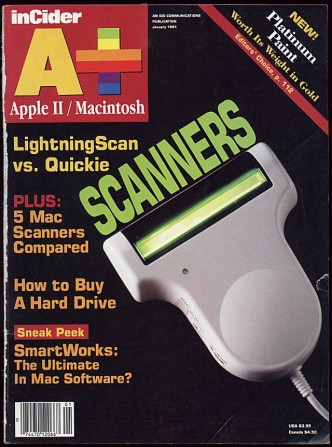 who had already had quite enough of Apple Computer telling them to "move up" to a Mac. "Polluting" their Apple II publication with this better-loved younger sibling infuriated many, and they vowed to let their subscriptions expire. However, at this point in time there were few national Apple II-specific publications remaining, and no others that appeared on the magazine racks at large newsstands (since Nibble had gone to subscription-only distribution). Apparently inCider's distributing company, A+ Publishing, felt that they couldn't survive without making some attempt to broaden their customer base, and they chose this as what they felt was their best defense in a shrinking market. For several months afterward, the magazine got just a little bit smaller in size, eventually going from a square-bound back to a stapled format. This shrinkage stabilized in early to mid 1992, and by late that year, inCider/A+ was still in business. who had already had quite enough of Apple Computer telling them to "move up" to a Mac. "Polluting" their Apple II publication with this better-loved younger sibling infuriated many, and they vowed to let their subscriptions expire. However, at this point in time there were few national Apple II-specific publications remaining, and no others that appeared on the magazine racks at large newsstands (since Nibble had gone to subscription-only distribution). Apparently inCider's distributing company, A+ Publishing, felt that they couldn't survive without making some attempt to broaden their customer base, and they chose this as what they felt was their best defense in a shrinking market. For several months afterward, the magazine got just a little bit smaller in size, eventually going from a square-bound back to a stapled format. This shrinkage stabilized in early to mid 1992, and by late that year, inCider/A+ was still in business.
However, rumors began to surface in October 1992 about plans by inCider to change to a format that would focus almost entirely on the Macintosh, with significantly less attention paid to the Apple II.[10] Initially, it was said that inCider/A+ would cease under that name with the January 1993 issue, and would reappear as just A+ in February 1993. Reasons cited at the time were declining advertising revenue, and they hoped that by changing themselves to deal with the Macintosh in more detail (particularly from the point of view of educators), they could continue to be printed.
Cameron Crotty, Associate Editor of inCider/A+, stated online in the A2 Roundtable on GEnie during October, "inCider/A+ is going primarily Macintosh. The shift will occur in February and will probably include a name change (not finalized). WE WILL CONTINUE TO COVER THE APPLE II FOR AS LONG AS IT REMAINS FEASIBLE. I cannot say (because I do not know) whether the coverage would be mixed in or in a separate section (input would be appreciated). With the shift in focus, we are also trying to enlarge the book..."
He also said, "Right now, inCider/A+ has two choices: 1) stay with the Apple II and be dead in 6-8 months or 2) shift to the Mac and try to survive. We believe that there is a low-end Mac niche at least as large as our current circulation (perhaps larger), and that most of our readers (75% or more) will maintain their subscriptions (numbers from editorial surveys & such). We also believe that we can attract the advertising we need to survive by shifting to the Mac. We may be wrong. We may be dead in 6-8 months anyway. But a change has to be made. We cannot survive on our current course."
There was, of course, considerable discussion of this planned move on the A2 Roundtable on GEnie. Some advertisers, like Quality Computers, threatened to withdraw their advertising entirely, if such a move took place. Perhaps it was because of statements like this, or perhaps Crotty spoke out without authority to do so. In any case, there was considerable back-peddling on the announcement that began to appear. Joe Kohn, who had been writing a column in inCider/A+ called "Shareware Solutions" for some time, stated that he had been told that there had as yet been no corporate decision to make any changes, and previous statements should be disregarded.[11]
inCider/A+'s new Editor-In-Chief, William Kennedy, wrote an editorial for the February 1993 issue of the magazine. In his editorial, he made great pains to point out that the rumors that had been flying about were never accurate from the beginning. Yes, with the March 1993 issue they had plans to redesign the layout of the magazine, and probably put the Mac stuff in a separate section, but he stated firmly that it would remain oriented to the Apple II.[12]
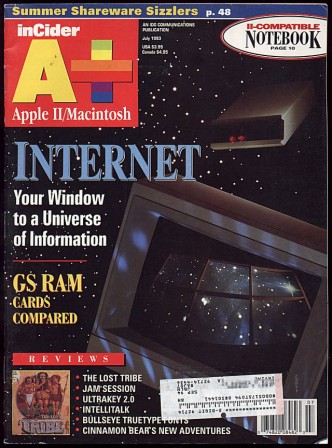
However, it was eventually clear that IDG Communications, the company that printed the magazine for A+ Publishing, was not going to continue to produce what they viewed as a losing venture. Quality Computers, which had decided by early 1993 to start their own Apple II magazine, arranged to take over inCider/A+'s remaining subscription base and fulfill it with their publication. inCider/A+ ceased publication with the July 1993 issue, but ended it as abruptly as did Softalk, with no announcement to subscribers to make them aware of the change until Quality Computers sent a letter discussing it. IDG then planned to begin a new Macintosh publication called Mac Computing, utilizing most of the old inCider/A+ staff. However, after the first issue was produced and distributed, IDG changed their minds and terminated the project.[13]
If the editors of inCider/A+ had chosen to maintain their focus on the Apple II, and had not taken the unpopular move of becoming a combination Apple II/Macintosh publication, perhaps they would have survived longer. Perhaps things would have still turned out as they did, even if they had remained true to their original topic. In any case, with the disappearance of inCider/A+, so also ended the era of newsstand Apple II magazines.
Apple IIGS Buyer's Guide (1985-1990)
This magazine began originally under the name, The Apple II Review in the Fall of 1985. After about five issues the name was changed to The Apple IIGS Buyers Guide. The changed magazine began in the Fall of 1987, and it ceased publication in the Fall of 1990. It was published in a high gloss format, and over half of each issue was devoted to a listing of available IIGS software/hardware.[6]
This magazine published from October/November 1985 until December/January 1986-87, by the same publisher of started by Antic magazine for the Atari 8-bit line of computers and later STart magazine for Atari's 16-bit computer line.[24] Trying to appeal to a variety of readers from beginners to experienced Apple II users, it printed program listings (including at one time listings made for the Cauzin strip reader), reviews, and general articles. It covered items in more depth than inCider, but less than Call-A.P.P.L.E. or Nibble, offering a combination of both type-in programs and general articles. It had available a companion disk available containing the programs in the magazine.[5],[7]
Open-Apple / A2-Central (1985-1995)
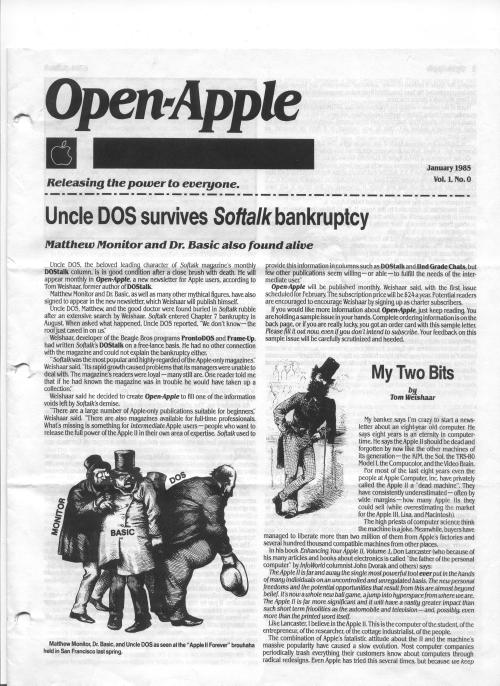 As mentioned previously, Tom Weishaar was a writer of Softalk's "DOSTalk" column beginning in April 1983, after Bert Kersey retired from the position. He continued with it until Softalk went bankrupt after the August 1984 issue. An Apple II user since 1980, and author of two programs sold by Beagle Bros (Frame-Up, a graphics slide-show displayer, and ProntoDOS, an enhanced version of DOS 3.3), Weishaar had previous experience with writing newsletters from his days with the Commodity News Service in Kansas City. After Softalk folded, he realized that there was still a market for a technical publication for the Apple II that also could be helpful for the beginning user. In January 1985 he began with a newsletter he called Open-Apple, which continued where "DOSTalk" left off. The initial issue (Volume 1, No. 0) included reader's letters (some left over from DOSTalk, but some intentionally phony, with return addresses like the Okefenokee Swamp), information about Applesoft and Logo, and one response to a reader asking how to create a disk that would boot without DOS 3.3. At $24 for a monthly eight page newsletter, its subscribing cost was as much as full-sized magazines of the day. However, Open-Apple did not carry any advertising, and the amount of useful information printed each month made it worth the expense.[8] As mentioned previously, Tom Weishaar was a writer of Softalk's "DOSTalk" column beginning in April 1983, after Bert Kersey retired from the position. He continued with it until Softalk went bankrupt after the August 1984 issue. An Apple II user since 1980, and author of two programs sold by Beagle Bros (Frame-Up, a graphics slide-show displayer, and ProntoDOS, an enhanced version of DOS 3.3), Weishaar had previous experience with writing newsletters from his days with the Commodity News Service in Kansas City. After Softalk folded, he realized that there was still a market for a technical publication for the Apple II that also could be helpful for the beginning user. In January 1985 he began with a newsletter he called Open-Apple, which continued where "DOSTalk" left off. The initial issue (Volume 1, No. 0) included reader's letters (some left over from DOSTalk, but some intentionally phony, with return addresses like the Okefenokee Swamp), information about Applesoft and Logo, and one response to a reader asking how to create a disk that would boot without DOS 3.3. At $24 for a monthly eight page newsletter, its subscribing cost was as much as full-sized magazines of the day. However, Open-Apple did not carry any advertising, and the amount of useful information printed each month made it worth the expense.[8]
As the newsletter matured over the years, the coverage of Logo disappeared, and Applesoft dwindled as well, reflecting changes in reader interests. During the late 1980's, coverage of AppleWorks was heavy, and nearly every issue would contain some way to patch the program to customize it for a certain function. Coverage of the IIGS was also prominent, and Weishaar and his various editors have struggled to find a balance between articles that dealt with the new technology without ignoring the sizeable number of readers who still owned the older 8-bit AppleII's.
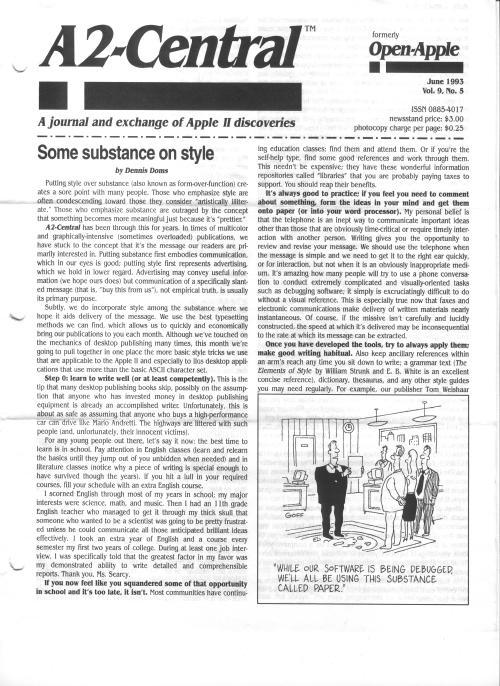 In December 1988, the name of the newsletter was changed to A2-Central. Several reasons were given for the change. One was similar to the reason given by A.P.P.L.E. for changing its name to TechAlliance; Apple Computer was in the habit of threatening legal infringement against those who used "their" name without permission (or at least licensing it). Another was to indicate philosophically what was the purpose of the magazine: To be the center of the Apple II universe, and a central source of information and programming resources. Earlier in the year, Weishaar had also agreed to be the manager of the Apple II roundtables on the online service GEnie. This extended the information available to him for his publication, as well as the ability for more prompt exchange of information for his readers. In fact, there was a great similarity between the conversations that took place on GEnie, in the reader questions section of A2-Central, and the old "Open Discussion" part of Softalk magazine. New users could ask "how do I get XYZ program to run with my ABC printer?." and experienced users could help them, either online or in a letter written to A2-Central. In December 1988, the name of the newsletter was changed to A2-Central. Several reasons were given for the change. One was similar to the reason given by A.P.P.L.E. for changing its name to TechAlliance; Apple Computer was in the habit of threatening legal infringement against those who used "their" name without permission (or at least licensing it). Another was to indicate philosophically what was the purpose of the magazine: To be the center of the Apple II universe, and a central source of information and programming resources. Earlier in the year, Weishaar had also agreed to be the manager of the Apple II roundtables on the online service GEnie. This extended the information available to him for his publication, as well as the ability for more prompt exchange of information for his readers. In fact, there was a great similarity between the conversations that took place on GEnie, in the reader questions section of A2-Central, and the old "Open Discussion" part of Softalk magazine. New users could ask "how do I get XYZ program to run with my ABC printer?." and experienced users could help them, either online or in a letter written to A2-Central.
Because the newsletter included international readers as well, and these people had difficulty in getting their hands on certain Apple II-related products or books, a catalog was added to the A2-Central line-up in early 1989. This initially carried books, but quickly expanded to include software and hardware. February 1989 also saw the first of A2 On Disk, which included a textfile of the current month's newsletter, as well as an assortment of the latest shareware and freeware programs for the Apple II. At times it also contained textfiles with useful information (such as updates to the official Apple II tech notes).
September 1989 saw a change in editors for A2-Central. After nearly five years of working constantly on it, Weishaar turned over the reins for the month-to-month work to Dennis Doms, and moved himself to the position of publisher. There was little change in the content or style of the newsletter (since Weishaar was still running the show), but it freed him to recover from the burnout of meeting a monthly deadline, and to work more on managing the company itself. One of the new items that appeared in December 1989 was a disk-based publication called Stack-Central (later changed to Studio City). What was unique about this bi-monthly product was that it was based on HyperStudio, the graphics, sound, and text manipulation program from Roger Wagner Publishing. As such, it could be read in a "non-linear" fashion; that is, you didn't have to start at the beginning and read through until you got to the end. You could jump from one topic to another, or thread through topics in a fashion that could not be duplicated in a printed publication.
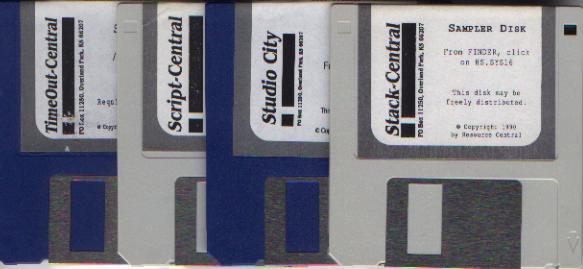
More new disk-based products appeared from A2-Central in 1990. August 1990 saw the start of TimeOut-Central, devoted to AppleWorks and the TimeOut series of enhancements distributed by Beagle Bros. It was also a bi-monthly publication, and was originally edited by Richard Marchiafava, who had previously written a column called "AppleWorks Advisor" for user-group newsletters. In March 1991 the editorship was transferred to Randy Brandt, the Beagle Bros programmer who had written many of the TimeOut applications, as well as several for his own small software company.
8/16-Central, specializing in programming for both 8-bit Apple II's and the IIGS, began in December 1990. It was a continuation of a short-lived magazine called 8/16, published by Ross Lambert's Ariel Publishing Co., which itself was preceded by several separate newsletters that specialized in Applesoft or assembly language or other programming for the Apple II series. 8/16-Central was a monthly disk, but didn't keep enough subscribers to stay afloat. In October 1991 it was discontinued, and the remaining subscriptions were folded over into GS+ Magazine. Later, the contents of the entire run of 8/16-Central were upload as individual file archives to A2Pro on the same exclusive basis as were the Apple Assembly Line files previously mentioned.
Weishaar's organization began to carry Hyperbole in March 1991. Produced by an outside source, it was also a HyperStudio-based disk publication, but its focus was not on making HyperStudio stacks, but on actually using the program to produce a literary form that had never been done before. It consisted of poetry, art, and sounds, combined together in a way that could not be presented in printed form. For example, one series of stories that appeared early on in Hyperbole involved a medieval theme, with the story told from various points of view, depending on which picture was selected on the "door" that introduced the story. To get the entire story required going back to the main door and selecting a different picture. Sound and graphics were also integrated into articles that appeared in this disk-magazine.
Finally, Script-Central began in June 1991. This was similar to Stack-Central, but was dedicated to HyperCard IIGS . It featured some animated sequences that introduced it, and the user could select the articles to read by pointing to doors in the Script-Central "building" on the screen, and follow hallways to other articles (sort of like combining a magazine and a video game).
A2-Central itself experienced few changes during these years. Its focus shifted slightly to keeping abreast of the newest changes in the Apple II world (in terms of products and events that affect that computer), whereas previously it spent a lot of time talking about various specific products (such as AppleWorks, HyperStudio, etc.) The spin-off disk publications that were started filled the niche needed to continue user-support of those Apple II products. The editorship changed a couple more times as well; Jay Jennings briefly took the place of Dennis Doms as editor in November 1991, before going to work for Softdisk. Ellen Rosenberg began editorship after that, and made the change of accepting feature articles from outside authors for the first time since A2-Central began publication.
When Nibble magazine folded in 1992, A2-Central took over their subscription list, filling out remaining issues for those people. It was hoped that many of those people would see enough value in A2-Central to renew when the time came, but not enough readers did so. Weishaar started up a new paper newsletter called Fishhead's Children, intended to be a resource for those who had to bridge themselves between the Apple II, Macintosh, and MS-DOS computers. However, the new publication did not have enough subscribers to maintain a positive cash-flow, and in June 1993 a letter was sent out to both Fishhead's Children and A2-Central subscribers:
|
Dear Subscriber,
Dominoes are falling at Resource Central and you've been hit.
As the Apple II nears the end of its life-cycle, renewals to our flagship publication, the paper version of A2-Central, have fallen to less than 20 per cent. That domino has been teetering ever since we took over Nibble's subscribers a year ago.
We had hoped to stabilize the situation with a new publications, Fishhead's Children, which would take us into new territory. Unfortunately, that publication hasn't been the success we had hoped it would be. For each $100 we've spent trying to obtain new subscribers, we've taken in less than $10. We can no longer carry this expense without putting our entire company in jeopardy, so that domino has ceased publication and fallen.
Without a successful Fishhead's Children, there's nothing to pay the even-increasing bills the paper version of A2-Central is running up. A2-Central-On-Disk continues to have strong renewals, as do our other disk publications, but they're not big enough to continue supporting our paper publications. It all means that I have no choice but to cease publication of the paper version of A2-Central as well.
|
The letter went on to explain that the value of remaining subscriptions (not counting the old Nibble people) would be credited to the subscriber's account, and could be refunded or applied to another product sold by Resource Central. A2-Central-On-Disk would continue to be produced as it had before; it cost much less to duplicate and mail disks than it did to print and mail paper newsletters. This would also be the place where the newsletter A2-Central would continue to appear (in a digital, rather than in a paper format).
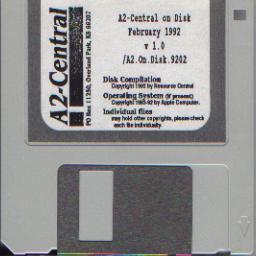 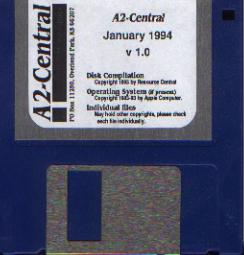
The January 1994 issue of A2-Central-On-Disk was renamed to simply A2-Central. Dean Esmay, who had been editing the disk publication from its beginning, went on to work with Softdisk in Louisiana, and newcomer John Peters came on as editor. The appearance of the text was dressed up in a manner similar to that used in the GEnie Lamp online newsletters, which Peters had been overseeing for several years. Not himself an Apple II user at the time when Weishaar signed him up, Peters gathered several veteran Apple II writers to assist in producing the text of the newsletter each month, and in collecting the freeware and shareware files that were included with each issue. At this time Steve Weyhrich's own independent monthly news compilation, the A2 News Digest, became exclusively a part of A2-Central. (The Digest had previously been available on GEnie as source material for Apple user group newsletters.) Doug Cuff, who was editor of the A2 edition of GEnie Lamp and a contributing editor for II Alive, was also tapped to write articles for A2-Central. Peters continued the practice started by Ellen Rosenberg of soliciting articles written by other authors not routinely associated with A2-Central.
Peters was also commissioned to coordinate work on Resource Central's disk publications for the Macintosh (called Macrocosm), and IBM and compatible computers (Solid Windows and Config.Sys, for the Windows and MS-DOS user, respectively).
The disk newsletter, catalog, and other disk publications continued under the corporate umbrella of Resource Central, Inc., which also continued to sponsor annual summer conferences up until 1995. These conferences brought together some of the top Apple II developers in the country for two days of classes and workshops on many topics. Held in Kansas City in July or August, it had been nicknamed "Kansasfest." since it contains AppleFest-like activities.
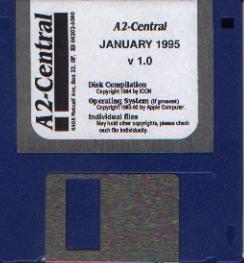 The gradual slide of interest in the Apple II continued over the year that Doug Cuff edited the disk-edition of A2-Central. The quality of the publication continued to be high, but due to continued financial constraints, Resource-Central (which had again been renamed, this time to "ICON") had to take the difficult step of shutting down operations in February 1995, bringing to an end all of their still-existing disk publications. The gradual slide of interest in the Apple II continued over the year that Doug Cuff edited the disk-edition of A2-Central. The quality of the publication continued to be high, but due to continued financial constraints, Resource-Central (which had again been renamed, this time to "ICON") had to take the difficult step of shutting down operations in February 1995, bringing to an end all of their still-existing disk publications.
Weishaar's interest in and dedication to the Apple II has been much appreciated; he was chosen s a recipient of the Apple II Individual Achievement Award for 1991. His philosophy was summed up in a statement made in a printing of the A2-Central catalog in the Fall of 1990, where he wrote: "The significant thing about the Apple II has always been the community of people that has sprung up around the machine, teaching other people how to use it, designing hard and software for it, exposing its inner flesh to the light of day, and using it to manage businesses, run church groups, educate children, and turn out prosperous and happy human beings."[9]
Compute! was a hybrid magazine that catered primarily to the Commodore 64 computer. It would usually feature games that had versions written for several different computers, including the Apple II. In the late 1980's it began having special issues dedicated to some of the different platforms featured in the main magazine, and there were a few issues called "Apple Applications" for the Apple II.
Apple Orchard was published by the International Apple Corp for several years.It was aimed primarily at user groups, and was billed as a user's group user's group. Contents of early issues were a compendium of articles from various user group newsletters.[3]
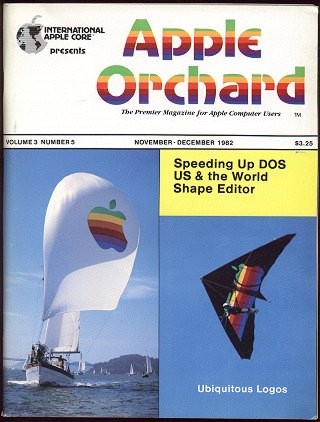
In the late 1970's, Steven Disbrow entered the world of microcomputers with his purchase of a TRS-80 Model I, complete with cassette storage and 4K of memory. To learn more about his computer and what it could do, he picked up a newsstand magazine called 80-Micro (published by Wayne Green, who had also started Byte and inCider magazines). He enjoyed the humor that the editors of that publication included, and the fun they showed one could have with a computer. Active also in the local TRS user's group, he originally disdained Apple II's and those who used them. However, in 1984 he found that he needed the ability to communicate with a mainframe computer in order to do some schoolwork. After looking into the cost of upgrading his TRS-80 to be able to do this, he found that it would actually cost him less to buy the newly released Apple IIc with a 300 baud modem (and at that time, a new IIc went for about $1300), so he crossed enemy lines and entered the Apple camp.
As he got more familiar with his IIc, his interest in that computer and the upcoming 16-bit IIGS also increased. While learning more about it from Apple magazines at the newsstand, he noticed that many of the publications that dealt with the Atari ST included a disk with each issue. Disbrow went so far as to contact several of the Apple II magazines that were in print at the time to see if they had any interest in a companion disk, but he did not find any interest. After purchasing his Apple IIGS, he saw that there still was no combination magazine and disk for this computer, and decided to start one himself.
When Disbrow started his magazine in September 1989, he chose to make it exclusively for the Apple IIGS, and so named it GS+. Published bi-monthly, the byline on the cover of each issue reminded subscribers of what made his magazine unique: "The First Apple IIGS Magazine + Disk Publication!" He recalled the humor and fun that he had always seen in 80-Micro, and determined to make his magazine fun in a similar way. Disbrow felt that this was especially important, considering the generally negative attitude that was prevalent among Apple II users at the time, as they saw less and less active support from Apple for their computer. Still in print at the time of this writing, GS+ concentrates on news, software and hardware reviews, published programs and utilities for the IIGS (some with source code), and interviews with people who are involved with the IIGS.[6]
Softdisk (Sep 1981-Aug 1995)
Softdisk GS (Nov 1989-Mar 1997)
One of the long-term survivors in the Apple II magazine world was also unusual in terms of the type of publication that it is. Rather than using the traditional paper and ink medium, Softdisk came on the scene as one of the first magazines distributed in only a machine-readable form. Back in 1981, Jim Mangham, a programmer at LSU Medical Center in Shreveport, Louisiana, felt that the time was ripe for an Apple II disk-based magazine. It would have the advantage of providing ready-to-run programs that did not have to be typed in, yet could still be listed and modified by the "reader" if desired. Mangham's idea was not unique in the computer world as a whole; CLOAD for the TRS-80 began as a magazine on cassette as far back as 1978, and other paper publications offered companion disks as an extra, containing programs from a specific issue. But no one had yet put a whole magazine on disk for the Apple II, and Mangham decided to fill that gap.
Originally, he planned to call it The Harbinger Magazette and after getting a preliminary first issue prepared, he called Al Tommervik of Softalk magazine to discuss advertising. Tommervik thought it was a great idea, and not only did he want to advertise it, but asked to be a partner in the venture. He suggested that they change the name to Softdisk (since it would be, in essence, a Softalk publication). By the time Mangham was ready to mail out his first issue, he had fifty subscribers. Since he needed a minimum of two hundred pieces to qualify for a bulk postage rate, his father found one hundred and fifty disks appear in his mailbox that month.
To create his new "magazette", Mangham chose to use double-sided disks that were pre-notched on both edges, to ensure that both sides would be useable. (Recall that the Disk II drive could only use one side of the disk, and so it was common to conserve money and use the other side by cutting a notch on edge of the disk opposite the factory one and flipping the disk over). These double-sided disks were expensive, costing him three dollars apiece, and so he set up the subscriptions to require return of the previous issue in order to get the next one (it was left up to the reader to make his own copies to keep). When the disk was returned with the five dollars for the next issue, the reader could also use a simple text editor on the disk to return any "letters to the editor" he might have, commenting on the previous issue's contents or asking other questions. This return disk could also be used for submitting programs, pictures, or articles for use in future issues of Softdisk. Some of the subscribers that became prolific contributors of material even ended up working at Softdisk![14]
Softalk magazine provided free advertising for Softdisk, and the subscriber base gradually grew. Some of the revenue for the magazine came from subscription payments, and some came through advertising. Ads for Softdisk were sold by the disk sector, and provided an advertiser a unique opportunity; he could give a potential customer a chance to actually see how the program he was selling looked. Some of the ads could be animated (usually using the text screen to use less disk space), and were actually entertaining. This was most prominent in the ads Softdisk had for their own products; by 1983 they had begun a line of software called "Rich And Famous" (which they said was what the authors wanted to become). Consisting of programs written by regular Softdisk contributors, these disks sold for $9.95 apiece, and a $4 royalty on each disk went to the author. The disks offered various types of games, including hi-res graphics adventures and card games, office-based utility software, general Apple II utilities, and disks of music (in Electric Duet format).
Each issue of Softdisk had a "cover" which consisted of a hi-res picture and the issue number. These eventually were created to look just like the Softalk logo, except the globe in the upper right corner was animated. Starting in August 1983, Softdisk expanded to two double-sided disks, and the two-way subscriptions now requested that only one of the two had to be returned. One-way subscriptions were also available by now, for those who didn't want to bother having to return the disks. By January 1984 (issue #27), Softdisk became available through retail stores (primarily computer stores, but later also through bookstores) at the price of $12.95 per issue. They also began putting out a disk magazine called "Loadstar" for the Commodore 64 computer in June 1984, at a price of $9.95 (since it was a single disk per issue it cost less).[15]
As mentioned earlier, Softalk magazine folded after its August 1984 issue, leaving the future of Softdisk somewhat in doubt. In return for some benefits that Softalk had provided (free full-page ads, space in their booth at computer shows, and permission to include some programs from the magazine on Softdisk), it had part-ownership in Softdisk. Since Softalk was now bankrupt, the possibility existed that Softdisk would be absorbed into the liquidation of assets. To avoid this outcome and to ensure the future of the magazine, Softdisk purchased back its shares from Softalk's creditors (at a price probably higher than what they were worth) and continued on their own. Although a few ads were placed in remaining Apple II magazines after that, Softdisk continued primarily on word-of-mouth referrals (which didn't increase circulation by much). Sales of some side items (primarily blank disks) helped keep the company going during this difficult time.[16]
In May 1985, the two-way disk subscriptions were discontinued, and Al Tommervik started a brief tenure as editor-in-chief. He helped develop a more professional appearance for the magazine (and for Loadstar), through higher quality graphics and cover design. When Greg Malone began as editor-in-chief in late 1985, he continued the improvements by starting a graphics-based presentation in favor of the older text-based method they had used from the beginning.[16]
Softdisk, Inc. added a disk magazine in 1986 for the IBM PC, called Big Blue Disk.[17] At this time Softdisk magazine itself began including re-releases of older commercial software whose publishers were willing to inexpensively release publishing rights; they also began to publish some newer shareware programs. The first series of "reprints" were games previously released by Polarware/Penguin Software.[18]
By 1987, Softdisk began again advertising itself in magazines. This began a large expansion in circulation for the Softdisk magazette and their other disk publications.[18] Later that year saw the changeover from the older DOS 3.3 operating system exclusively to ProDOS (beginning with issue #73). This issue also saw the start of a more attractive graphic user interface that supported use of a mouse (as well as the keyboard), and had pulldown menus and animated graphics. Within the next year or so, retail distribution of their publications was discontinued (booksellers were not leaving the products on the shelf long enough to allow them to sell) and distribution returned exclusively to a subscription basis.[19]
The first issue of Softdisk GS was released in November 1989, supporting the Apple IIGS desktop interface guidelines. This publication maintained a high standard of quality and did well while the Apple IIGS lasted.
After issue 113 of Softdisk, the previous programming team had moved on to create games in the IBM PC world, and Peter Rokitski was hired to do programming for each issue of the disk magazine. By the end of its run, Softdisk for the Apple II was literally run by Rokitski alone, as he filled the role of programmer, editor, quality assurance and issue assembler, doing everything but duplicating and mailing the disks. The last edition of Softdisk was #166, completed in August 1995. Rokitski later became the editor for Softdisk GS, and continued in that position until its last issue, #82, was released in March 1997.[25]
As of May 2002, Softdisk, Inc. existed primarily as a web-hosting and Internet storefront service, as well as a purchase-and-download site for Windows, Macintosh, and Palm OS software. Softdisk's monthly disk publications have gradually been discontinued, with Loadstar for the Commodore 64/128 having lasted the longest, but also no longer being produced. Big Blue Disk for the IBM PC later was later renamed On Disk Monthly in 1991, then became Softdisk CGA (for non-graphics-based PC's) and Softdisk PC in 1993. Softdisk CGA ceased publication in 1996, and the same happened to Softdisk PC in 1998. Softdisk for Windows ran from 1994 until 1999. Diskworld for the Macintosh was launched in 1988, changed to Softdisk for Mac in 1993, and discontinued in 1998.[25]
When reviewed in July 2006, access to www.softdisk.com redirects to www.bayou.net, an Internet hosting service. However, the "about" page for Softdisk still gives a timeline for the company.
II Alive (Mar 1993-Present)
Joe Gleason was the president of Quality Computers, an Apple II mail order company based in St. Clair Shores, Michigan. He observed with considerable concern the gradual erosion of Apple II-specific information through the format of the traditional slick magazine. When inCider/A+ added Macintosh coverage, this began the gradual decline in the fortunes of that magazine, which was Quality's major advertising outlet. Quality had begun a combination magazine and catalog called Enhance, with a focus towards educators (where the Apple II was still fairly strong). But Gleason wanted something more.
Jerry Kindall, who worked at Quality and was a frequent presence on the online services, made this announcement in October 1992: "When inCider/A+ decided to switch over to a primarily Macintosh focus, we decided the time was right for us to start our own Apple II publication to fill the void. II Alive will begin publication in...1993. Every single article will discuss the Apple II. Every single ad will promote Apple II products. The Mac will be mentioned only in connection with the Apple II (as will the IBM)--for example, in articles on networking or file exchange."[22]
They planned to initially offer the magazine on a bi-monthly basis, and for people who subscribed before December 31, 1992 they offered a free video tape that highlighted new Apple II products.[22] A sample issue of the magazine was mailed out to everyone on Quality's mailing list in early 1993, and the first official issue appeared in March 1993. The logo on the cover had a circle around the title announcing the flavor of the magazine, "Celebrating The Apple II". Kindall was named as editor-in-chief, and eventually had some other staff hired to help him: Ellen Rosenberg, as managing editor (formerly editor of A2-Central); Doug Cuff as consulting editor (also editor of the online magazine GEnie Lamp A2 and writing for A2-Central); and Tara Dillinger as Interview Editor (who was also in charge of doing online interviews on the A2 Roundtable on GEnie).
Regular columns featured in II Alive included "Test Drives" (reviews of new products), "Ask Mr. Tech" (technical questions and answers), "Head Of The Class" (programs that were of particular interest to educators), "AppleWorks At Large" (tips on uses for that program), "Macro Exchange" (sample UltraMacros programs for AppleWorks), "Modem Nation" (information about telecommunications), "Shareware Spy" (discussion of freeware and shareware software), and more.
Compared to inCider, this magazine seemed to be having fun in the various articles it presented, and attempted to capture a little of the flavor of Softalk from the old days. Because of Quality's introduction of AppleWorks 4.0 in the fall of 1993, the November/December issue was not available until late in December (Kindall also was responsible for writing the manual for that program); however, after this they worked hard at returning to their correct bi-monthly schedule. At this time, II Alive is the only glossy magazine that deals with both the 8-bit and 16-bit versions of the Apple II.
Shareware Solutions II (1993-Present)
Joe Kohn had been writing articles and a regular column called "Shareware Solutions" for inCider for quite a while, when the rug got pulled out from under him by the demise of the magazine. He had taken extra efforts to make disks available to readers who didn't have modems, disks that contained some of the best available shareware and freeware programs he could find. To continue in these efforts, in mid-1993 he decided to begin a self-published newsletter called Shareware Solutions II. He posted on GEnie that his newsletter would "take Apple II users on an exciting journey into the future. Each month, I plan to write articles about freeware/shareware (of course) and will continue to provide low cost freeware/shareware disks to subscribers via the mail. There will also be Apple II oriented reviews and articles that focus on low cost solutions to common Apple II problems. There will be columns geared to novices and new modem owners; techies, hackers, teens, senior citizens and educators alike should find lots to interest them...Subscribers will learn how to tame their Apple II computer, and will learn what it will take to make their Apple II a powerful computer solution well into the next century and beyond."
"I believed it when Apple proclaimed 'Apple II Forever', and Shareware Solutions II will help to make that more than just an empty slogan!"[23]
Rather than to try to stick to a specific publishing schedule, Kohn decided to sell his subscriptions on the basis of the number of issues, rather than by the year. As his bi-monthly schedule fell behind at times this plan turned out to be wise. And the content of his newsletter reflected the extra care that could be taken when a deadline didn't have to be rigidly adhered to; his first few issues have been excellent, including some special offers of commercial software for readers. Hopefully Shareware Solutions II will be around for a long time.
Foreign Apple II Magazines
The Apple II not only got press in the United States, but has also been on the newsstands in Europe in various forms, though most are no longer being published. One that began as Windfall (later changing its name to Apple User) was the biggest magazine for some time. Peeker was published in Germany, and carried articles similar to those found in Nibble . In the Netherlands there are still a few hobbyist magazines that cater to the Apple II crowd, including Klokhuis (which means Apple-Core), Pro-2 and Het AppleDossier.[20]
In Britain there was at one time a magazine called Orchard Computing, published by a company named Argus Specialist Publications. Some of the issues were primarily reprints from Nibble, but they also accepted articles from local readers.[21]
|

